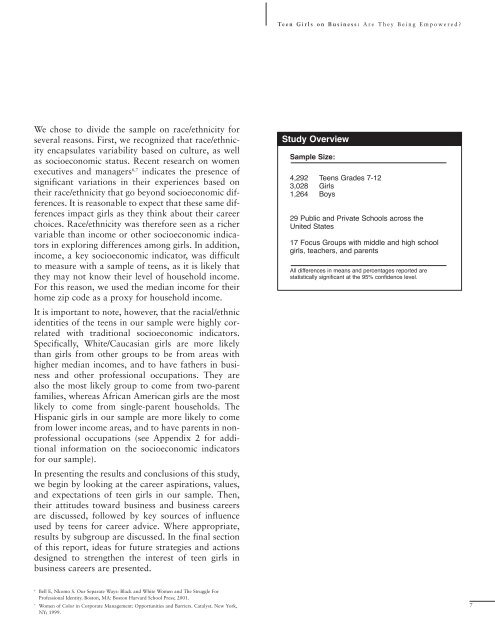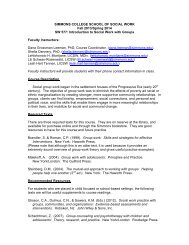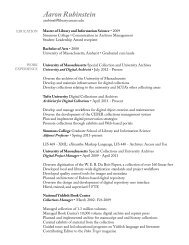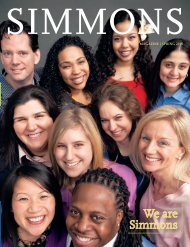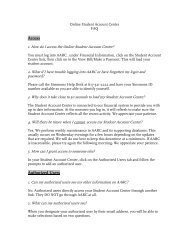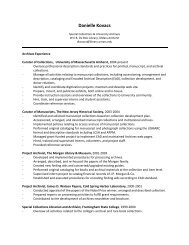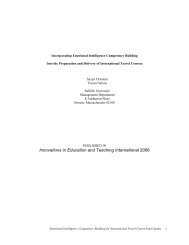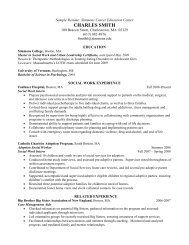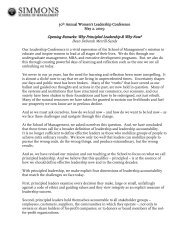Teen Girls on Business - Simmons College
Teen Girls on Business - Simmons College
Teen Girls on Business - Simmons College
Create successful ePaper yourself
Turn your PDF publications into a flip-book with our unique Google optimized e-Paper software.
<str<strong>on</strong>g>Teen</str<strong>on</strong>g> <str<strong>on</strong>g>Girls</str<strong>on</strong>g> <strong>on</strong> <strong>Business</strong>: Are They Being Empowered?We chose to divide the sample <strong>on</strong> race/ethnicity forseveral reas<strong>on</strong>s. First, we recognized that race/ethnicityencapsulates variability based <strong>on</strong> culture, as wellas socioec<strong>on</strong>omic status. Recent research <strong>on</strong> womenexecutives and managers 6,7 indicates the presence ofsignificant variati<strong>on</strong>s in their experiences based <strong>on</strong>their race/ethnicity that go bey<strong>on</strong>d socioec<strong>on</strong>omic differences.It is reas<strong>on</strong>able to expect that these same differencesimpact girls as they think about their careerchoices. Race/ethnicity was therefore seen as a richervariable than income or other socioec<strong>on</strong>omic indicatorsin exploring differences am<strong>on</strong>g girls. In additi<strong>on</strong>,income, a key socioec<strong>on</strong>omic indicator, was difficultto measure with a sample of teens, as it is likely thatthey may not know their level of household income.For this reas<strong>on</strong>, we used the median income for theirhome zip code as a proxy for household income.It is important to note, however, that the racial/ethnicidentities of the teens in our sample were highly correlatedwith traditi<strong>on</strong>al socioec<strong>on</strong>omic indicators.Specifically, White/Caucasian girls are more likelythan girls from other groups to be from areas withhigher median incomes, and to have fathers in businessand other professi<strong>on</strong>al occupati<strong>on</strong>s. They arealso the most likely group to come from two-parentfamilies, whereas African American girls are the mostlikely to come from single-parent households. TheHispanic girls in our sample are more likely to comefrom lower income areas, and to have parents in n<strong>on</strong>professi<strong>on</strong>aloccupati<strong>on</strong>s (see Appendix 2 for additi<strong>on</strong>alinformati<strong>on</strong> <strong>on</strong> the socioec<strong>on</strong>omic indicatorsfor our sample).In presenting the results and c<strong>on</strong>clusi<strong>on</strong>s of this study,we begin by looking at the career aspirati<strong>on</strong>s, values,and expectati<strong>on</strong>s of teen girls in our sample. Then,their attitudes toward business and business careersare discussed, followed by key sources of influenceused by teens for career advice. Where appropriate,results by subgroup are discussed. In the final secti<strong>on</strong>of this report, ideas for future strategies and acti<strong>on</strong>sdesigned to strengthen the interest of teen girls inbusiness careers are presented.Study OverviewSample Size:4,292 <str<strong>on</strong>g>Teen</str<strong>on</strong>g>s Grades 7-123,028 <str<strong>on</strong>g>Girls</str<strong>on</strong>g>1,264 Boys29 Public and Private Schools across theUnited States17 Focus Groups with middle and high schoolgirls, teachers, and parentsAll differences in means and percentages reported arestatistically significant at the 95% c<strong>on</strong>fidence level.6Bell E, Nkomo S. Our Separate Ways: Black and White Women and The Struggle ForProfessi<strong>on</strong>al Identity. Bost<strong>on</strong>, MA: Bost<strong>on</strong> Harvard School Press; 2001.7Women of Color in Corporate Management: Opportunities and Barriers. Catalyst. New York,NY; 1999.7


